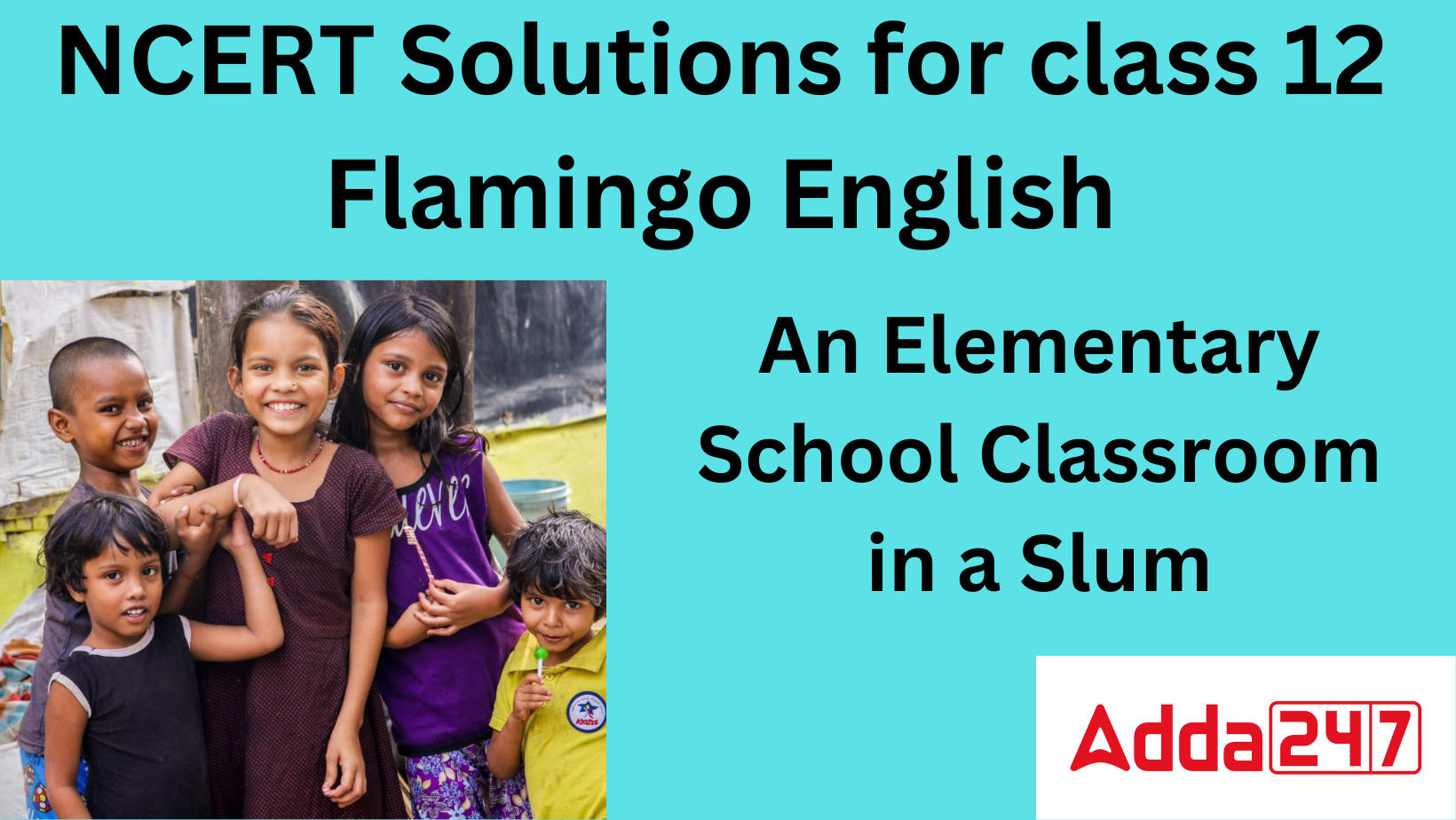Table of Contents
NCERT Solutions for Class 12 English Flamingo Chapter 2 An Elementary School Classroom in a Slum: Introduction
The social injustices that exist in society are described in a poem by Stephen Spender. He discusses the state of the pupils at an elementary school that is located in a slum region in the poem. The poet hopes to attract everyone’s attention to these youngsters so that their lives can be made better and they can be taught how to be decent citizens rather than criminals.
NCERT Solutions For Class 12 English Flamingo Chapter 2: Video Explanation
Watch the given video explanation of An Elementary School Classroom in a Slum
NCERT Solutions For Class 12 English Flamingo Chapter 2 An Elementary School Classroom in a Slum: PDF
A PDF is given below for the students’ accessibility which they can download for future reference
An Elementary School Classroom in a Slum
NCERT Solutions For Class 12 English Flamingo Chapter 2 An Elementary School Classroom in a Slum: Question Answers
Page no. 93
Think it out
Que. Tick the item which best answers the following:
(a) The tall girl with her head weighed down means the girl:
(i) is ill and exhausted
(ii) has her head bent with shame
(iii) has untidy hair
Ans: The correct answer is an option (ii) is ill and exhausted. The kid must have been tired from accompanying her mother around the home with housework and then coming to school.
(b) The paper-seeming boy with rat’s eyes means the boy is:
(i) sly and secretive
(ii) thin, hungry, and weak
(iii) unpleasant looking
Ans: The correct answer is option (ii) thin, hungry, and weak. Most of the children in slums are not provided access to proper food and nutrition which can make them extremely thin and weak.
(c) The stunted, unlucky heir of twisted bones means the boy:
(i) has an inherited disability
(ii) was short and bony
Ans: The correct option is (i) has an inherited disability. The kid must have inherited some genetic disability that would have passed to him from his parents or grandparents. The condition provides him twisted bones and a lack of proper stature.
(d) His eyes live in a dream. A squirrel’s game, in the tree room other than this. This means the boy is:
(i) full of hope in the future
(ii) mentally ill
(iii) distracted from the lesson
Ans: The correct answer is option (iii) distracted from the lesson. The child wasn’t interested in what the lesson had, instead he was busy remembering the things he loved and the games he played with his friends.
(e) The children’s faces are compared to ‘rootless weeds’. This means they:
(i) are insecure
(ii) are ill-fed
(iii) are wasters
Ans: The correct answer is an option (iii)are wasters. The simile tells us that there is nothing to ground the children. They are completely unwanted by society, and no one is bothered about their existence.
Que. What do you think is the colour of ‘sour cream’? Why do you think the poet has used this expression to describe the classroom walls?
Ans. The colour “sour cream” denotes a worn-out, soiled, yellow tint. Because the school was not in a decent state, the poet chose this phrase to describe the classroom walls. It denotes that the school hasn’t had any new paint applied in years, which has caused the existing paint to darken. Additionally, it describes how the absence of facilities in the room has a negative impact on the youngsters that are there.
Que. The walls of the classroom are decorated with pictures of ‘Shakespeare’, ‘buildings with domes’, ‘world maps’ and beautiful valleys. How do these contrast with the world of these children?
Ans. They are introduced to the world outside the slums through the vibrant, lovely images on the wall. These images show how their way of life contrasts with that of someone who has everything. Since they haven’t seen or explored the world in the photograph, it serves as a window for them to envisage life outside of the school’s dirty walls. Lack of adequate facilities, food, and education are all examples of poverty. The images may also encourage the children to leave the neighbourhood where they were raised in order to further explore the world and create a better future for themselves. The depiction of their planet is in contrast to the global map. The “small street shut in with a lead sky” is a metaphor for children.
Que. What does the poet want for the children of the slums? How can their lives be made to change?
Ans. The poet wishes the children to escape their current position of deprivation. He encourages them to explore the areas marked on the map and take advantage of what life has to offer. They are only kept in a depressed state by the classroom environment, which is depressed and nasty. In order to help children escape the lead sky they are so accustomed to seeing, suitable education must be offered for them. Children may accomplish anything they set their minds to and can be blessed with the future of their dreams with the right support, resources, and optimism. They could enjoy life, not be discouraged by physical restrictions, or be worn out from work.
NCERT Solutions Class 12 English Flamingo Chapter 2 An Elementary School Classroom in a Slum: FAQs
Que. Who is the writer of the poem “An Elementary School Classroom in a Slum”?
Ans. Stephen Spender
Que. What is the theme of the poem “An Elementary School Classroom in a Slum”?
Ans. The theme of the poem is the social injustice and class inequality faced by slum children.
Que. What are the benefits of using the NCERT Solutions for Class 12 Flamingo English poem 2 from Adda247?
Ans. The benefits of using the NCERT Solutions for Class 12 Flamingo English poem 2 from Adda247 are:
- Along with NCERT Solution, student is getting video explanation also.
- PDF is also provided that can be downloaded and saved for future reference.





 NEET UG 2025: Is NEET Previous years Que...
NEET UG 2025: Is NEET Previous years Que...
 JEE Mains Session 2 Result 2025 OUT, Sco...
JEE Mains Session 2 Result 2025 OUT, Sco...
 TS Inter Results 2025 Date for TSBIE 1st...
TS Inter Results 2025 Date for TSBIE 1st...






